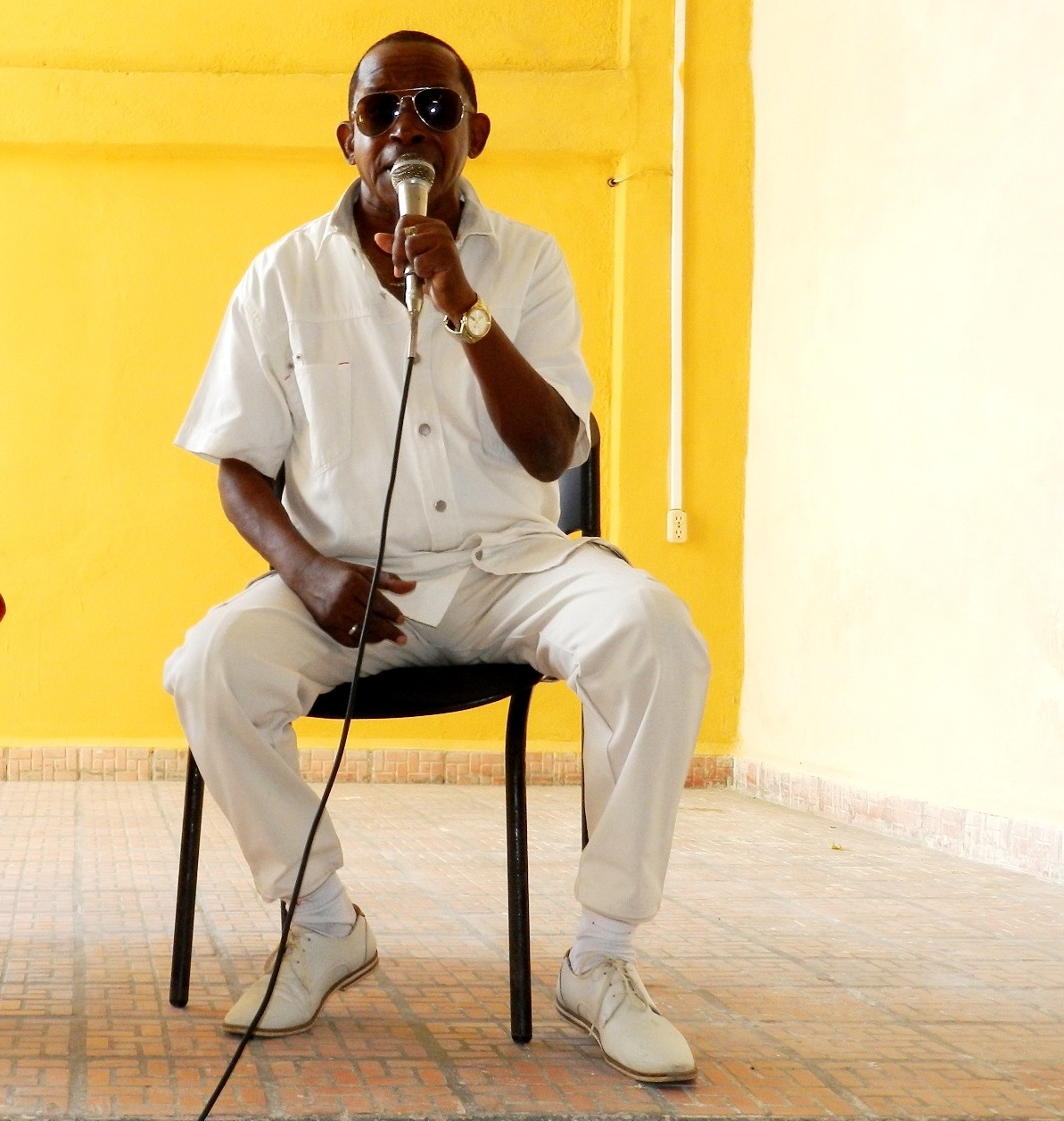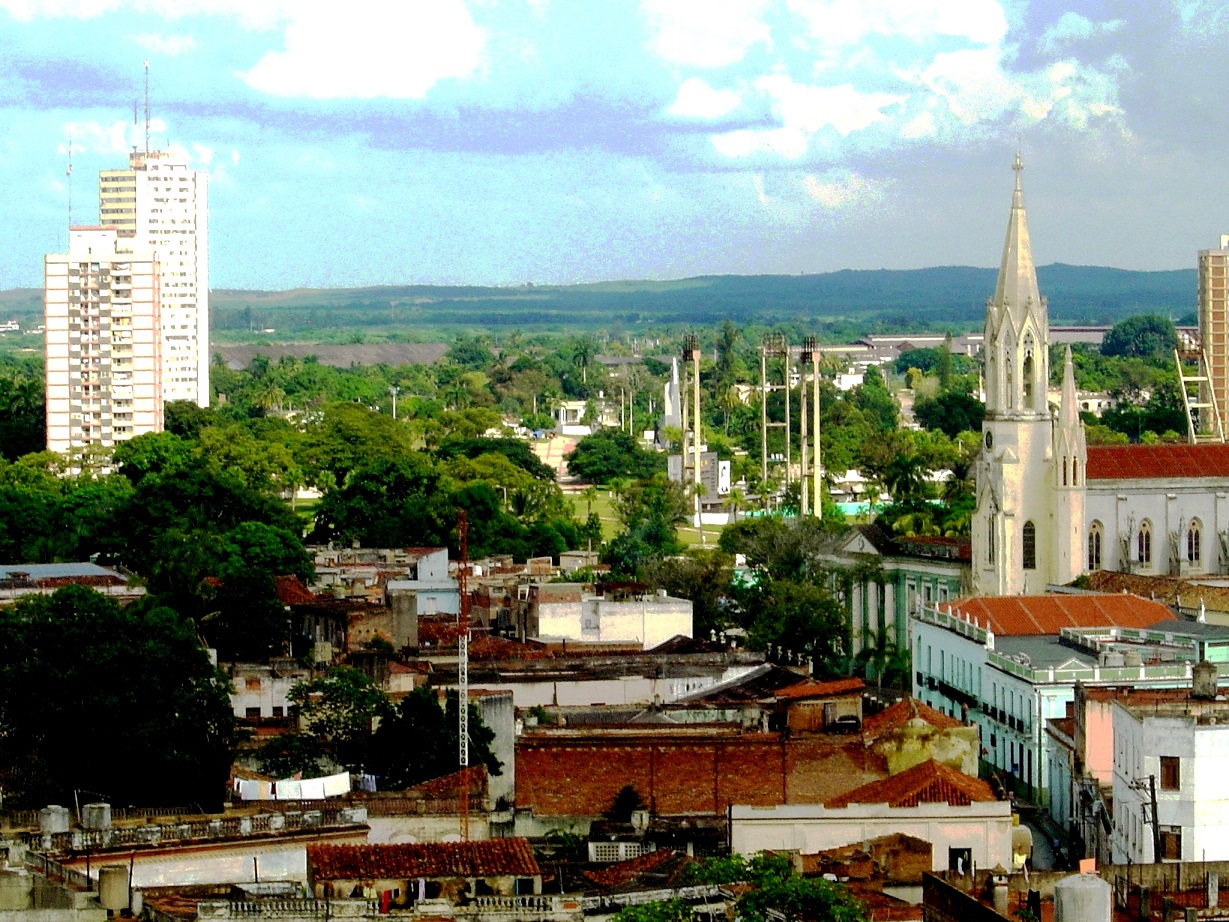 Orlando Guerra Soa, «Cascarita»
Orlando Guerra Soa, «Cascarita»
Lázaro David Najarro Pujol
Fotos autor e Internet
La peculiar manera de interpretar las guarachas y sones sobre el escenario del cantante, bailarín e improvisador camagüeyano Orlando Guerra Soa, «Cascarita», fue reflejada en fotografías de la época y confirmada por su amigo de juventud, su coterráneo Jorge Sicilia.
Para el compositor cubano Bebo Valdés (1919-2013), «Cascarita», conocido también en el universo musical en la mayor de las Antillas como «El guarachero de Cuba», era «el mejor cantante de mambos que dio Cuba». Nació en Camagüey el 14 de septiembre de 1920.
Sus primeros éxitos como intérprete profesional los alcanzó en su tierra natal, al igual que en la ciudad de Santa Clara. Sus melodías se escuchaban en la emisora CMHI de los magnates tabacaleros los Hermanos Trinidad, que luego daría origen a la estación RHC Cadena Azul, en La Habana.
Considera el vocalista Roberto Simón, estudioso de la obra de Orlando Guerra, que su hermano era un popular tumbador de la antigua orquesta Tridimensional que dirigía el maestro Ramonín Vega. «Cascarita», que era un cantante rítmico, debutó en Camagüey acompañado entre otros, de Silvia González, Blanca Margarita Gómez, Servando Vázquez y Candita Batista.
«Él utilizaba su habilidad del humor para mezclarlo con la música popular cubana, además lo hacía muy bien», opinó el también presidente de la filial agramontina de Música de la UNEAC.
Se le recuerda por su espectacular interpretación de guarachas y sones compuestos por Julio Cueva (1897- 1975), entre los que resaltan «Tingo Talango», «Rascando siempre rascando» y «El marañón». «Pobrecitas las mujeres», «Qué caló», «En tiempo de mangos» y «Dos cosas pa’ tomá con leche».
Joaquín Eduardo Varona Lezcano, director y asesor de programas musicales de Radio Cadena Agramonte reveló que tuvo la suerte de entrevistar al amigo de juventud en Camagüey de Orlando Guerra. «Además, estudiaron en la misma escuela».
A Orlando Guerra le pusieron «Cascarita» porque durante una gira pidieron pan con queso.
—Pero mira esto, solo tiene un pedacito de queso. ¡Esto es cascarita! ¡Esto es cascarita!, le reclamó a la dependiente.
Sus propios compañeros de viaje se burlaron de él por la justa observación:
—¡Orlando, tú eres «Cascarita»!
A partir de ese momento se quedó con el sobrenombre de «Cascarita».
Según el testimonio ofrecido por Jorge, se distinguía por su sentido del humor. Era muy carismático y de mucha creatividad en el escenario.
Me contó Jorge Sicilia, que Benny Moré aprendió mucho de «Cascarita», en cuanto a su estilo, no sólo musicalmente, sino también en la manera extravagante de vestir y comportarse en el escenario.
Coincide Simón Roberto que Cascarita fue un referente para Moré, en la forma de decir y de proyectarse. «Era un personaje natural, cómico. De solo mírarle con su leva que le quedaba ancha. Mientras que el Benny usaba el saco largo, Cascarita sobre lo ancho, con corbatas extravagantes».
Precisa Varona Lezcano que Cascarita «fue un personaje muy popular en Cuba en los años de 1930 a 1940. En Camagüey comenzó bailando tap. Era un bailarín excepcional de tap. Se presentó muchas veces en el Teatro Principal de esta ciudad. Tenía muchos admiradores y admiradoras».
«Me aseguró Jorge que en una oportunidad se presentó en una emisora de Camagüey y como faltó un músico él cantó acompañado por la orqquesta y fue todo un éxito por su timbre, su voz… Fue cuando se hizo muy popular aquí».
«Vestía de una forma muy llamativa: pantalones y sacos anchos y sombrero… Fue muy famoso por las guarachas». Pude escuchar una entrevista realizada en vivo por Germán Pinelli a Cascarita, famosa en los diálogos, el empleo de doble sentido y las metáforas.
Precisamente en 1948, contratado por la emisora CMQ, Orlando Guerra participaba diariamente en un show nocturno animado con Pinelli. El locutor y el cantante formaban un dúo humorístico chispeante.
Considera Eduardo Varona Lezcano, integrante de la filial camagüeyana de Radio, Cine y Televisión que es necesario rescatar del olvido a una figura como Orlando Guerra Soa. Actualmente es desconocida en Cuba.
«Personalmente vine a conocer la impronta de Cascarita en la música y la cultura cubana en general, luego de que el locutor Ángel Eduardo Rosillo Heredia (1929-2015) desarrollara un conversatorio con un grupo de realizadores en el contexto de un Festival Nacional de Radio», efectuado en Camagüey.
Explicó Varona Lezcano que Rosillo presentó unas grabaciones de canciones interpretadas por el músico camagüeyano y conversó mucho sobre su trayectoria como cantante, reconocido en el ámbito musical como un camagüeyano de fama universal.
«En México, fue también muy famoso. Cantaba y bailaba mambo, guaracha, son… Era un improvisador por excelencia», añadió Varona Lezcano.
Orlando Guerra Soa, participó en 1968, en su última incursión importante en discos respaldados por la orquesta del pianista mexicano Memo Salamanca. Su timbre de voz continuaba intacto. Falleció en la capital de México el 30 de marzo de 1973.
 Coincide Simón Roberto que «Cascarita» fue un referente para Moré, en la forma de decir y de proyectarse.
Coincide Simón Roberto que «Cascarita» fue un referente para Moré, en la forma de decir y de proyectarse. Camagüey, cuna del cantante, bailarín e improvisador camagüeyano Orlando Guerra Soa.
Camagüey, cuna del cantante, bailarín e improvisador camagüeyano Orlando Guerra Soa.
Orlando Guerra Soa, participó en 1968, en su última incursión importante en discos respaldados por la orquesta del pianista mexicano Memo Salamanca. Su timbre de voz continuaba intacto. Falleció en la capital de México el 30 de marzo de 1973.
http://www.uneac.org.cu/noticias/orlando-guerra-soa-cascarita-un-camagueyano-de-fama-universal
Orlando Guerra Soa «Cascarita»: a man from Camagüey of universal fame
By Lázaro David Najarro Pujol / Photos by the author and Internet
September, 2020.- The peculiar way of interpreting the guarachas and sones on the stage of the singer, dancer and improviser from Camagüey Orlando Guerra Soa «Cascarita», was reflected in photographs of the time and confirmed by his youth friend, his countryman Jorge Sicilia .
For the Cuban composer Bebo Valdés (1919-2013), «Cascarita», also known in the musical universe in the largest of the Antilles as «El guarachero de Cuba», was “the best mambos singer that Cuba gave”. He was born in Camagüey on September 14, 1920.
His first successes as a professional interpreter were achieved in his native land, as well as in the city of Santa Clara. Their melodies were heard on the CMHI radio station of the tobacco magnates the Hermanos Trinidad, which would later give rise to the RHC Cadena Azul station in Havana.
Vocalist Roberto Simón, a student of Orlando Guerra’s work, considers that his brother was a popular tumbador of the old Tridimensional orchestra led by maestro Ramonín Vega. «Cascarita», who was a rhythmic singer, made his debut in Camagüey accompanied, among others, by Silvia González, Blanca Margarita Gómez, Servando Vázquez and Candita Batista.
“He used his ability of humor to mix it with Cuban popular music, he also did it very well,” said the also president of the Camagüey’s Music branch of UNEAC.
He is remembered for his spectacular interpretation of guarachas and sones composed by Julio Cueva (1897-1975), among which are Tingo Talango, Scratching always scratching, El cashew, Poor women, Que caló, En tiempo de mangos and Dos cosas pa ‘Take with milk.
Joaquín Eduardo Varona Lezcano, director and music program advisor for Radio Cadena Agramonte, revealed that he was lucky enough to interview Orlando Guerra’s friend from his youth in Camagüey. “Also, they studied at the same school.”
They called Orlando Guerra “Cascarita” because during a tour they asked for bread and cheese.
“But look at this, it only has a piece of cheese.” This is shell! This is skinny! He claimed the clerk.
Her own fellow travelers mocked her for the just observation:
“Orlando, you’re ‘Cascarita’!
From that moment he stayed with that nickname.
According to the testimony offered by Jorge, he was distinguished by his sense of humor. He was very charismatic and very creative on stage.
Jorge Sicilia told me that Benny Moré learned a lot from “Cascarita” in terms of his style, not only musically but also in the extravagant way of dressing and behaving on stage.
Simón Roberto agrees that Cascarita was a reference for Moré in the way of saying and projecting himself. “He was a natural, comic character. Just looking at him with his cam that was wide. While Benny wore the long jacket, Cascarita over the width, with extravagant ties ”.
Varona Lezcano specifies that Cascarita “was a very popular character in Cuba in the years from 1930 to 1940. In Camagüey he began dancing tap. He was an exceptional tap dancer. It was presented many times in the Main Theater of this city. He had many admirers and admirers.
Jorge assured me that on one occasion he appeared on a station in Camagüey and as there was a musician missing, he sang accompanied by the orchestra and was a great success because of his timbre, his voice … It was when he became very popular here.
He dressed in a very conspicuous way: wide pants and jackets and a hat… He was very famous for the guarachas ”. I was able to listen to a live interview conducted by Germán Pinelli with Cascarita, famous in dialogues, the use of double meanings and metaphors.
Precisely in 1948, hired by the CMQ radio station, Orlando Guerra participated daily in an animated night show with Pinelli. The announcer and the singer were a sparkling humorous duo.
Eduardo Varona Lezcano, a member of the Radio, Cinema and Television branch of Camaguey, considers that it is necessary to rescue a figure like Orlando Guerra Soa from oblivion. It is currently unknown in Cuba.
“I personally came to know the imprint of« Cascarita »in Cuban music and culture in general, after the announcer Ángel Eduardo Rosillo Heredia (1929-2015) developed a discussion with a group of filmmakers in the context of a National Festival Radio ”, held in Camagüey.
Varona Lezcano explained that Rosillo presented recordings of songs performed by the musician from Camagüey and talked a lot about his career as a singer, recognized in the musical field as a Camagüey of universal fame.
“In Mexico, he was also very famous. He sang and danced mambo, guaracha, son… He was an excellent improviser ”, added Varona Lezcano.
Orlando Guerra Soa captivated audiences on his 1942 tour to Puerto Rico, where he recorded with the Pepito Torres orchestra for RCA Víctor. He was well known for his sarcastic style, named after words from the street language.
When the musician and composer Julio Cueva, created his own orchestra in 1944, «Cascarita» became a star singer (the popularity of the group increased), without leaving his commitments and recordings with the Palau Brothers until 1949.
Meanwhile, in June 1945, the Camagüey was hired by Liduvino Pereira, director of the Casino de la Playa Orchestra, to make recordings with that group, with tremendous success for the songs Consuélate, by Silvestre Méndez; Vive regalá, by Hermenegildo Cárdenas; The what how, by Jesús Guerra; Take the tail, by Iván Fernández; This is the latest, by Rafael Blanco Suazo; and I pick a bread, I want a hat and Panchita died, by Félix Cárdenas.
After “Cascarita” acting in different second-rate cabarets, provincial stages and with ensembles and other groups that were not really up to his level, he settled in 1960 in Mexico City.
The singer Simón Roberto, who organizes the Peña del Bolero in Camagüey, said that Benny Moré was contextualized by his super relevant performances in the great nightclubs of Havana and other nations. It stimulated the interest of great businessmen in the world, luck that Cascarita did not have, although he participated in tours of Colombia, Panama, Puerto Rico and Venezuela.
Orlando Guerra Soa participated in 1968 in his last major foray into records backed by the orchestra of the Mexican pianist Memo Salamanca. His voice timbre was still intact. He died in the capital of Mexico on March 30, 1973. (Translated by Linet Acuña Quilez)